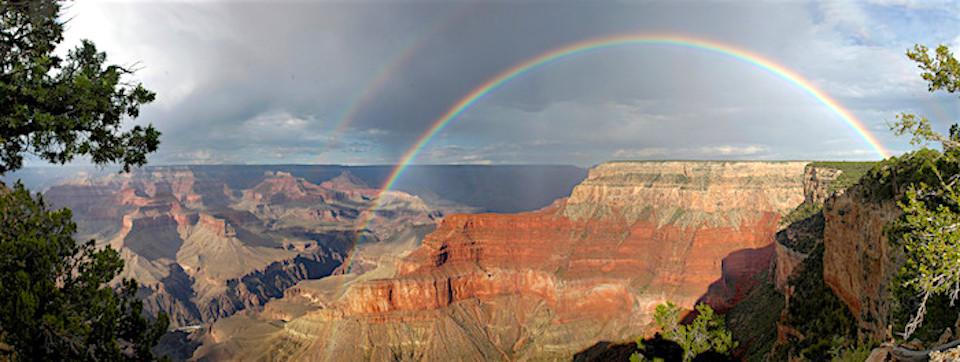
There are two central arguments as to why Grand Canyon National Park remains open during the coronavirus argument, and neither supports the health and safety of park employees/NPS file
There are two sides, at least, as to why Grand Canyon National Park remains open during the coronavirus pandemic, and history would point to the answer being Arizona's governor wants it open.
A popular answer, one that's appeared on the Traveler, is that Interior Secretary David Bernhardt so far has refused to let the park close down, even though the acting superintendent, the Intermountain Region director for the National Park Service, and even David Vela, the de facto director of the National Park Service, are in agreement that the park should be closed.
When asked about that, the Park Service's reponse has been that the agency has been working "within the local and the State of Arizona's Health Department's as well as the CDC's guidelines," to determine whether the park should be closed.
Secretary Bernhardt in the past hasn't been such a stickler for process, as an observant Traveler reader pointed out the other day. After all, the Interior secretary ignored process (and regulations) a year ago when he tapped Federal Lands Recreation Enhancement Act funds to pay salaries for Park Service employees called back to work during the partial government shutdown, and again last August when he ordered the Park Service to expand access for eBike users.
While the latest deliberation over the health of Grand Canyon employees and visitors has been going on, more than a few other units of the National Park System have closed, including more than a few that are in their off-season, when few if any visitors are about. Glacier (23,989), Acadia (20,161), Yellowstone (28,695), and Lassen Volcanic (7,944), just to name four parks that have closed in their entirety, combined don't attract as many visitors at this time of year as does Grand Canyon (451,228).*
Local government entities also have called for the Grand Canyon's closure; among them, the Coconino County Board of Supervisors, the Navajo Nation, Tusayan Chamber of Commerce, and the Tusayan Fire Department.
One park that closed on Monday was Cumberland Gap National Historical Park, which touches Kentucky, Virginia, and Tennessee. In explaining the closure, Superintendent Charles Sellars said that, “(V)isitors need to think hard about the trickle-down effect of their, ‘All I’m doing is going out for a hike.’ If a visitor were injured, the park’s limited staffing would literally mean hours for a rescue. Once a rescue is initiated, the park’s emergency response personnel would be at high risk due to the close proximity required to stabilize the visitor and also during the carry out. An injured visitor puts additional strain on medical personnel at hospitals already dealing with the novel corona virus.”
Furthermore, the superintendent pointed out that the personal protective equipment the park needs for its staff could be better used by hospitals and other medical facilities in the country that are struggling to obtain enough. We don't know how many personnel at the Grand Canyon need PPE, but it's safe to guess a lot more than at Cumberland Gap.
For those who say Arizona Gov. Doug Ducey is adamant that Grand Canyon stays open, well, they have a good argument. Back in December 2018, as the federal government was heading into its partial shutdown, the governor stated that, "the Grand Canyon will not close on our watch."
Ducey wasn't the first Arizona governor to take such a stance.
Back in 1995, another time when the federal government shut down over a budget impasse, then-Arizona Gov. Fife Symington showed incredible moxie by trying to engineer a takeover of Grand Canyon National Park rather than see it shuttered.
Backed by National Guard troops and wielding a misinformation campaign with hopes of keeping the National Park Service off-balance, the governor's ambitions at one point were ridiculed in an editorial cartoon depicting a Civil War-era, saber-wielding officer astride a horse at the park's entrance gate where a ranger pointed out that, "I don't care who you are, Mr. Most Excellent Exalted Son of the Morning Poohbah Fifemaster the Third, or whoever. The park is closed."
The fact that Ducey has declared golf courses "essential services" should show where he comes down on the question of closing Grand Canyon National Park. We tried to contact the governor's office on this question, but after being on hold for 30 minutes the phone went dead.
Ducey, did, however, issue an executive order Monday urging Arizonans to stay home.
"Keeping Arizonans safe and healthy as we slow the spread of COVID-19 remains our top priority,” the proclamation stated.
At the end of the day, the Grand Canyon is a federal property, with federal employees who are being put at risk by staying on the job and dealing with visitors. While there are two central arguments of who's responsible for keeping the park open, neither supports the health and safety of those employees.
*March 2019 visitation.



Comments
Ducey finally issued a stay at home order today (effective tomorrow) but it has a load of 'essential services', including park employees to keep parks open, so this may not change just yet.